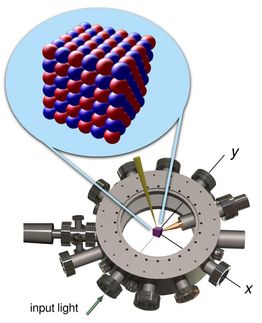Switching superconductivity by light
Advertisement
A research team led by Prof. Hiroshi M. Yamamoto of the Institute for Molecular Science, National Institutes of Natural Sciences has developed a novel superconducting transistor which can be switched reversibly between ON and OFF by light-irradiation. This achievement is a milestone for future high-speed switching devices or highly-sensitive optical sensors.
The field-effect transistor (FET) is a basic switching element that controls electrical current in electronic circuits. FETs are currently included in a variety of electronic devices such as smart phones and computers. In recent years, much effort has been devoted to develop a superconducting FET as a key technology for computations using quantum states.
In 2013, the research team developed the world's first organic superconducting FET based on the organic superconductor: κ-(BEDT-TTF)2Cu[N(CN)2]Br (κ-Br). Their previous work has allowed the organic superconducting FET to be recognized again as having inherent advantages such as flexibility and designability.
In this research, the team fabricated a novel photo-switchable transistor by replacing the gate electrode in the conventional FET with a 'spiropyran'-thin-film. When Dr. Masayuki Suda, a member of the research team, shone a pale UV light on this novel FET, it showed a rapid decrease of electrical resistance and turned into a superconducting state after 180 seconds. Spiropyran is a photo-active organic molecule that shows intra-molecular electrical polarization by UV light irradiation. In this system, carriers for the superconductivity can be accumulated by UV light-induced electrical polarization of the spiropyran-film. Dr. Suda also found that the device can be switched to the superconducting state both by gate-voltage control and light-irradiation control. Such a multi-mode operation obtained by combining two kinds of functional molecules, BEDT-TTF and spiropyran, indicates the high designability of organic systems. The superconductivity could also be removed by visible light-induced depolarization of the film.
This research presents a novel concept in which "superconductivity can be switched by optical stimuli," and will drive innovation in the field of future high-speed switching devices or high-sensitivity optical sensors. "Now it takes 180 seconds to switch the FET, but it can be operated much faster in principle," said Dr. Suda, "and it will open a way to a new type of devices that can satisfy glowing demand for a high-speed information infrastructure."
Original publication
Masayuki Suda, Reizo Kato, Hiroshi M. Yamamoto; Light-induced superconductivity using a photo-active electric double layer; Science
Other news from the department science
Most read news
More news from our other portals
See the theme worlds for related content
Topic world Sensor technology
Sensor technology has revolutionized the chemical industry by providing accurate, timely and reliable data across a wide range of processes. From monitoring critical parameters in production lines to early detection of potential malfunctions or hazards, sensors are the silent sentinels that ensure quality, efficiency and safety.

Topic world Sensor technology
Sensor technology has revolutionized the chemical industry by providing accurate, timely and reliable data across a wide range of processes. From monitoring critical parameters in production lines to early detection of potential malfunctions or hazards, sensors are the silent sentinels that ensure quality, efficiency and safety.





























































